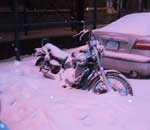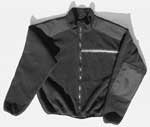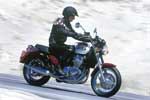
Riding in the COLD & Winter
Riding a Motorcycle in Cold and Snow
Most people park their motorcycles when temperatures dip, but you can safely
-- and comfortably -- ride in colder temperatures
than you might believe, if you prepare properly. From the December 1998 issue
of Motorcycle Cruiser magazine. By Art Friedman.
 There
are some days -- and nights -- when you simply aren't going to ride, no matter
how prepared you are. This one, for instance.
There
are some days -- and nights -- when you simply aren't going to ride, no matter
how prepared you are. This one, for instance.
Winter is officially here when I put on heavy gloves without hesitating to
ponder whether unlined leather gloves will do the job. It's officially cold
when my fingers get chilled even though I am wearing heavy winter gloves.
When it's that cold, most people, especially here in Southern California,
don't even think about riding.
You can ride in temperatures below freezing safely and even comfortably, but you have to dress properly. An extended ride in cold weather can get you into trouble if you are not prepared.
To plan for a ride in frigid conditions, it's important to understand how your body deals with cold. The prime directive of your body's warmth-management system is to protect the brain and other vital organs. It will therefore direct warmth to those areas at the expense of other less critical parts, notably the extremities. If your hands and feet start to get cold, it may be because your body is using its resources to heat the more important components. On the other hand, if you make sure your head and torso are protected frrom wind and well-warmed, your hands are likely to stay warm with fewer layers. A wind-chill chart. such as this this one from the National Weather Service, can give you some idea of what you are up against. You can see how dramatically the air moving over your skin sucks away your body's warmth. Therefore you should make busting the breeze a prime consideration.
Deflect and Defend
 One
of the advantages of a full-face helmet is that the faceshield flips up, so
you can keep if from fogging when you stop. A flip-face helmet like this lets
you do even more without removing it.
One
of the advantages of a full-face helmet is that the faceshield flips up, so
you can keep if from fogging when you stop. A flip-face helmet like this lets
you do even more without removing it.
Warming your head is relatively easy, providing you wear a full-coverage helmet.
A helmet provides a windproof shell and a thick layer of insulation, from
the impact-absorbing EPS and comfort foams inside. After that, it's just a
matter of filling in the gaps. You can lessen the wind that leaks in with
a ski mask, a scarf, or something like the Aerostich
Wind Triangle, a Chase
Harper Breeze Buster or Leather Bandana, or a Roadgear
Windcheater Bandanna. Just be sure a little fresh air gets in, or you may
run out of oxygen. In any event, your neck area should be thoroughly covered,
since blood circulates through it between your brain and your vital organs.
If you wear an open-face helmet you will be colder, but a full face shield and windproof, insulated covering over your lower face and neck will help. Snowmobile shops have a selection of face masks and fog-resistant face shields. A shorty helmet offers even less insulation, and one of those beanie-like helmets offers as little protection from the cold as it does in an accident (an insignificant amount).
For your torso, the best line of defense is a wide windshield which also extends below the headlight, to minimize air coming up from underneath. The windproof quality of leather makes a leather jacket the ideal outer layer for cold rides. This can be the same jacket you use in midsummer if it has vents that close tight. On warm days, my hip-length, Firstgear Kilimanjaro jacket (no longer available, unfortunately) provides ample airflow with its vents open. And on cold rides, inserting the thermal liner and an additional layer or two underneath keeps me comfortable in below-freezing temperatures. The belted waist and extended length prevent wind from sneaking up my back. Leather overpants also make an effective cold fender for your legs. Your legs might require more insulation than your torso if you have a windshield. If you can afford apparel for every season, dedicated winter leathers are ideal. Some leather manufacturers market such items to the snowmobile industry.
Nonleather snowmobile suits can also provide good protection from the cold for a more affordable price. They won't provide the security of leather if you need abrasion protection, however.
Layers and Heaters
 Any
outer layer should stop the passing air and seal it out. Theis Roadgear's
Windcheater.
Any
outer layer should stop the passing air and seal it out. Theis Roadgear's
Windcheater.
These days there are a number of good synthetic materials, such as fleece,
to use as intermediate layers under a jacket. The Roadgear
Windcheater jacket is made of windproof, tightly woven fleece, and works well
as a thermal liner under another jacket. In addition, street riders have something
even better in the form of electric clothing. Available from several companies
-- including Aerostich, Gerbing's, and the original, Widder -- electric apparel
attaches to the bike's electrical system and adds heat where you need it.
See the comparison
of electric apparel in the "Accessory and Gear" section of MotorcycleCruiser.com,
which also has links to the electric apparel companies' websites.
Although it's tempting to buy electric gloves only (because hands get cold the most) start your electric clothing collection with a vest, for the reasons mentioned above. Most riders say an electric vest extends the riding pleasure zone about 20 degrees downward on the thermometer, without adding layers of clothing. Thus, if you get cold enough that you are no longer having fun at 50 degrees, an electric vest could keep you happy down to 30 degrees. If you want added warmth in other regions, you can find chaps and gloves, too. Sporting goods stores also sell inexpensive electric socks which use their own batteries. I have a pair but I've never needed them because my feet usually stay warm below freezing if I use an electric vest.
The most important piece of electric apparel is a vest or
jacket liner. It will even warm you feet and hands.
 One
problem you will encounter is perspiring when you aren't riding. In fact,
by the time you get the extra gear on and hit the road, you are probably pretty
sweaty. Of course, once you get moving, that moisture performs its intended
function and cools you off. The outdoor clothing industry has a raft of underwear
material designed to wick moisture away from your skin. Although I don't sweat
much for a fat guy, none of the garments I have tried have proven exceptional
in this role. Nonetheless, they are generally better than traditional underwear
or sock material.
One
problem you will encounter is perspiring when you aren't riding. In fact,
by the time you get the extra gear on and hit the road, you are probably pretty
sweaty. Of course, once you get moving, that moisture performs its intended
function and cools you off. The outdoor clothing industry has a raft of underwear
material designed to wick moisture away from your skin. Although I don't sweat
much for a fat guy, none of the garments I have tried have proven exceptional
in this role. Nonetheless, they are generally better than traditional underwear
or sock material.
Speaking of moisture, I like to drag along a rainsuit on a cold day. If it rains or snows it seals out the wet stuff, and the suit can provide an additional wind barrier if it gets colder than expected.
Hands and Feet
For the same reason, I like to wear waterproof boots and gloves. I have a roomy pair of boots I press into service with heavy socks during rides that promise cold. If your only riding boots are lightweight and offer neither waterproofing nor room for extra socks, a pair of hiking or similarly heavy boots (especially a pair with insulation) may be a better bet. By the way, wearing your pants outside your boots keeps you much warmer than vice versa.
It may be tempting to just use electric gloves if you have
cold hands, but an electric vest is a better way to go, even for freezing
fingers. Add the gloves to the vest for maximum effect.
 There
are a number of gloves that meet my waterproof, cold-stopping criteria, with
two-finger gloves and electric gloves topping the warmth meter -- if they
allow for a good feel on the controls. Mittens are warmer still but make lever
control awkward. Again, I like leather for its crash protection, and a firm
retention system is also high on my list of desirable glove attributes. Gauntlets
that fit snugly over the sleeves of your jacket are essential. Since those
sleeves may be fairly bulky, they may require gauntlets that seem awfully
large on their own. Lightweight liners worn under the gloves can improve warmth
by controlling perspiration and keep your hands comfy at gas stops, etc.
There
are a number of gloves that meet my waterproof, cold-stopping criteria, with
two-finger gloves and electric gloves topping the warmth meter -- if they
allow for a good feel on the controls. Mittens are warmer still but make lever
control awkward. Again, I like leather for its crash protection, and a firm
retention system is also high on my list of desirable glove attributes. Gauntlets
that fit snugly over the sleeves of your jacket are essential. Since those
sleeves may be fairly bulky, they may require gauntlets that seem awfully
large on their own. Lightweight liners worn under the gloves can improve warmth
by controlling perspiration and keep your hands comfy at gas stops, etc.
Another effective device for keeping your hands warm are covers that attach to the handlebar and completely enclose the grip area and your hands, such as Harper Hands offered by Chase Harper. These pods are most useful for riders who ride regularly in very cold weather. You can also deflect wind with off-road style hand guards, and some riders cut large plastic bottles, such as those used for liquid bleach, in half and clamp them in front of the grips and levers to, er, break wind.
One of the problems you will encounter in cold weather is a fogged face shield (or goggles). If it's cold enough, the fog will turn to frost. A Fog City Fog Shield will solve the problem during the day but it may create other problems at night. Some of the commercial antifog solutions can be effective, and I have had good luck with a thin film of soap polished onto the inside surface of a face shield.
Unexpected Cold
All of the above are great ways to prepare for the cold when you know it's coming, but what if you get caught in the cold unexpectedly? One of the reader's tips we receive most frequently is the old trick of putting newspaper under your jacket for insulation. Many major grocery stores and most sporting goods stores sell cheap rainsuits that will reduce the amount of air that reaches you. If you can't find any, large trash bags will work too. Remeber to cover the vital areas -- head and torso.
If you start to get cold, get inside and drink something warm. Stay there until you are warm again. Once you become thoroughly chilled, your ability to control the bike will deteriorate. As cold permeates your body and hypothermia sets in, you will get clumsy and then stupid -- not a great combination for a motorcyclist. If you can't get inside, try calisthenics at the side of the road or seek other shelter. I know of a rider who flagged down a policeman and asked to sit in his car. The policeman put him in the back seat and patrolled for a while, then returned him to his bike. Do not drink alcohol, even though it will briefly make you feel warm. After the initial warmth, you will feel colder than before.
Preride planning can help you be ready for any change in the weather. I spend a lot of time browsing the Weather Channel before a long ride, because its coverage is broader than the local stations'. It pays to remember changes in altitude will change temperatures as well. Although the standard rate of temperature drop is about four degrees for every 1000 feet you climb, I know of one 4500-foot climb from desert to mountains where the drop can be as much as 40 degrees Fahrenheit. It can also be sunny at the bottom and snowing 15 miles up the road.
Snow and Ice
If it was not such a warm day (despite the snow), he'd want
his face covered to prevent being chilled in a hurry.
If you get caught in a snowstorm, don't panic. Riding on snow just requires
you to slow down, be very smooth, and allow plenty of distance to stop. Make
ultragentle inputs with brakes, clutch, steering and throttle. Make sure no
one is following too closely. Falling down at low speed on a slick surface
probably won't hurt you, but if the car behind you can't stop or doesn't know
how, it will be nasty. Also, don't expect drivers to recognize how precarious
things are. Falling snow will make you harder to see and they will cut you
off, turn in front of you, and stop without warning. Unless it's a light,
brief snow or you are close to home, head for the closest motel or eatery,
or the quickest way out of the storm. (Go back down the mountain, for example.)
The other hazard of cold weather is ice. Watch out for those bridges that freeze before the roads do, and be alert for black ice in shady areas. More than one rider I know has crashed on unseen ices in Southern California's canyons on winter nights. If you must cross an icy patch or even a suspected one, keep the bike slow, straight and steady, and minimize the inputs as mentioned above. Squeezing in the clutch and free-wheeling across the ice will keep you from applying either too much or too little power to the rear wheel. As a rule, you will be steadier with your feet on the pegs or floorboards than dragging them. Also watch for sand placed in corners to deal with the ice.
If you have the proper gear and avoid the slick spots, riding in cold weather can be as comfortable and fun as riding on warm days. And the investment you make in cold-weather gear simply enhances your investment in your bike.
Art Friedman
If you have questions or comments about this article, email the author at
Art.Friedman@primedia.com or at ArtoftheMotorcycle@hotmail.com.
Wednesday, June 18, 2014 22:03


